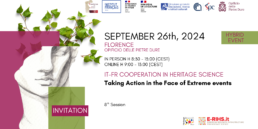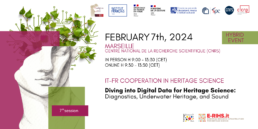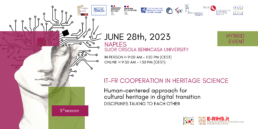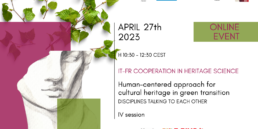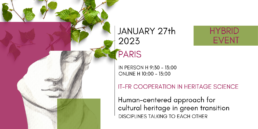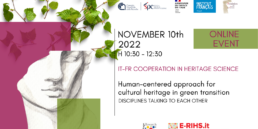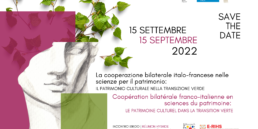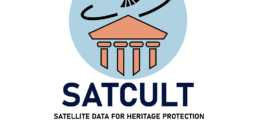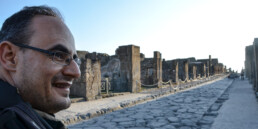IT-FR cooperation in Heritage Science
Hybridisation of human knowledge and digital technologies
Exploring the frontiers of digital imaging for cultural heritage research and intervention
October 19th 2023 | Online Event
H 10:30 AM - 12:30 PM (CEST)
Within the framework of the Italian-French bilateral cooperation in Heritage Science, the sixth event will be focused on “Hybridisation of human knowledge and digital technologies: exploring the frontiers of digital imaging for cultural heritage research and intervention”.
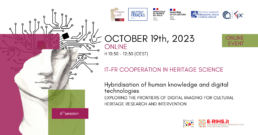
The online event will take place on October 19th from 10:30 am to 12:30 pm (CEST).
We are excited to bring together experts from different fields to discuss the current context of cultural heritage in the digital transition.
The organisation of the event has been coordinated by the Istituto di Scienze del Patrimonio Culturale del Consiglio Nazionale delle Ricerche, the French Ministry of Culture, the Fondation des Sciences du Patrimoine, the Institut Français Italia, the French Embassy in Italy and the Direzione Generale Educazione, ricerca e istituti culturali of the Italian Ministry of Culture.
Registration is open!
To ease the organisation of the seminar and confirm your participation, you need to register for the event.
Please remember that registration will be open until the 13th of October.
We look forward to seeing you online on October 19th!
Presentations by speakers at the event are available here
Hybridisation of human knowledge and digital technologies
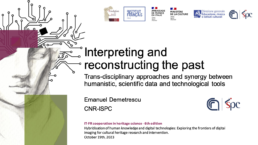
Interpreting and reconstructing the past
Trans-disciplinary approaches and synergy between humanistic, scientific data and technological tools
In the attempt to interpret and reconstruct the past, a transdisciplinary approach that combines languages from different disciplines is essential. This synergy creates new tools and methods that help researchers face the challenges of documenting and analysing archaeological finds, monuments, and historical objects. During our presentation, we will explore the opportunities and challenges of combining ‘hard’ scientific data obtained from technological tools (such as 3D surveys and sensor data in the non-visible spectrum) with ‘soft’ data, such as photographs, texts, and written testimonies, enabling a more complete and accurate view of the past. During the presentation, concrete examples will be presented from research carried out as part of the studies for the construction of the Rome Metro Line C and the UNESCO site of Cerveteri.
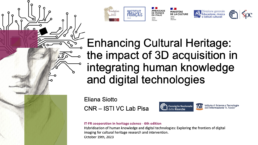
Enhancing Cultural Heritage
The impact of 3D acquisition in integrating human knowledge and digital technologies
3D acquisition technologies play a pivotal role in the preservation and enhancement of Cultural Heritage. Utilising 3D geometric data, in conjunction with targeted processing and algorithms, serves as the cornerstone for non-invasive and non-contact diagnostics. This technology acts as a crucial conduit for integrating data from historical-archival research and scientific investigations. Simultaneously, it facilitates the hybridisation of real and virtual data to support restoration and polychrome reconstructions. Furthermore, it enables seamless information and data exchange by developing web-based platforms. This presentation aims to elucidate the significant impact of 3D geometric models in harmonising human expertise with state-of-the-art technologies. It draws on experiences gained from analysing the wooden support of Leonardo da Vinci’s Adoration of the Magi, reconstructing fragments from the 15th-century Madonna of Pietranico, investigating ancient polychromy on Roman sarcophagi housed in the Vatican Museums, the Capitoline Museums, and the National Roman Museum collections, as well as examining Antonello da Messina’s Ecce Homo in the Alberoni Gallery in Piacenza.
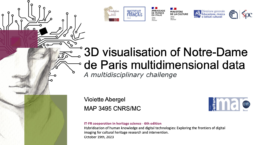
3D visualisation of Notre-Dame de Paris multidimensional data: a multidisciplinary challenge
The Notre-Dame scientific action involves around 200 researchers from disciplines such as archaeology, anthropology, architecture, history, chemistry, physics and computer science.
The corpus built up through the collection of pre-existing digital data and the gradual aggregation of data produced by these members since the start of the project is now both rich and heterogeneous. It is caracterised by a wide variety of file formats, natures, temporal states and scales, and conveys very different meanings depending on the communities of researchers who use it. In response to the resulting exploration and analysis challenges, a 3D viewer has been developed. Its aim is not only to spatialise all these resources in a common reference system to ease their visualisation, but, above all, to link them together by simultaneously exploiting their geometric, visual, semantic and temporal properties in order to provide new multidisciplinary analysis methods.
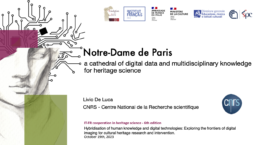
Notre-Dame de Paris : a cathedral of digital data and multidisciplinary knowledge in heritage science
Cultural heritage research makes the confrontation between material objects and multidisciplinary studies the arena for the production of collective knowledge. In the digital age, this is then a privileged setting for the study of the collective analysis and interpretation of facts, objects and phenomena, bringing together a new generation of data to build new scientific and cultural resources – our tomorrow’s heritage. How can one memorise these bundles of individual gazes directed at one and the same object of study? How to analyse their dynamics of construction, overlap and fusion leading to new knowledge? Our research introduces a new field – a field of multidisciplinary and multidimensional digital data – as raw material for studying the mechanisms of knowledge production in heritage science. With an innovative approach to computational modelling and digitisation, we’re using the exceptional experimental setting of the Notre-Dame de Paris scientific action (involving 175 researchers from disciplines such as archaeology, anthropology, architecture, history, chemistry, physics and computer science) to build a corpus of data on scientific practises in cultural heritage research in the digital age.
By introducing and experimenting next-generation methods and tools for the semantically-enriched data production and analysis, we aim to shift the cursor of digitisation from the physical object to knowledge about the object, in order to analyse the interdependence between the complex features of the material object and the associated knowledge objects built by scholars through their research practises.
Further information
The event is sixth of a series of seminars.
- The first event held in Rome on September 15th, 2022
- The second event held online on November 10th, 2023
- The third event held in Paris on January 27th, 2023
- The fourth event held online on April 27th, 2023
- The fifth event held in Naples on June 28th, 2023
For further information about previous events, we invite you to visit the pages dedicated to the Italian-French partnership for heritage science.
